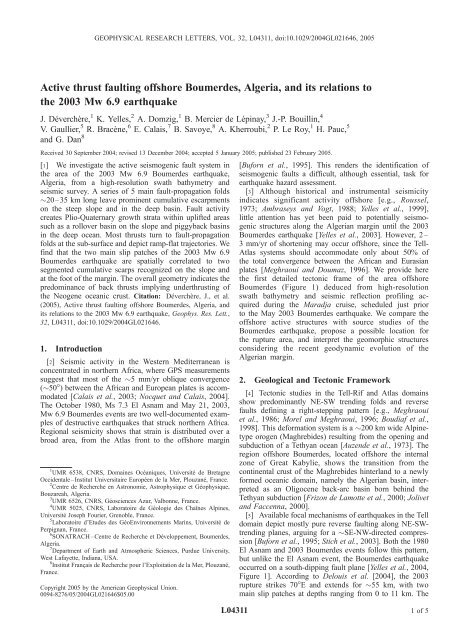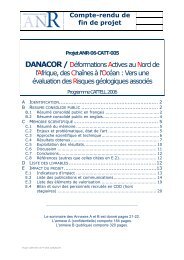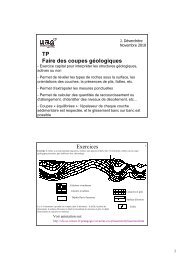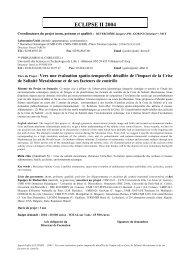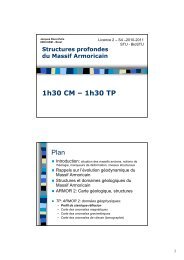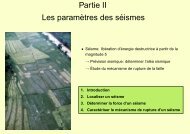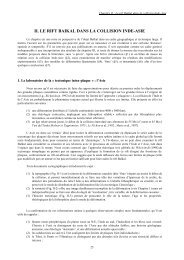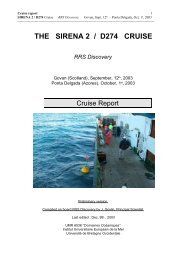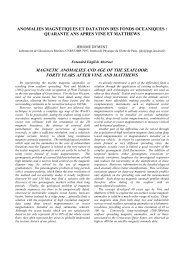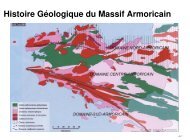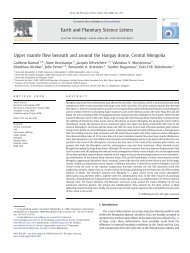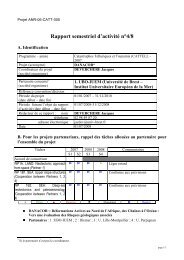Active thrust faulting offshore Boumerdes, Algeria, and its relations ...
Active thrust faulting offshore Boumerdes, Algeria, and its relations ...
Active thrust faulting offshore Boumerdes, Algeria, and its relations ...
You also want an ePaper? Increase the reach of your titles
YUMPU automatically turns print PDFs into web optimized ePapers that Google loves.
GEOPHYSICAL RESEARCH LETTERS, VOL. 32, L04311, doi:10.1029/2004GL021646, 2005<br />
<strong>Active</strong> <strong>thrust</strong> <strong>faulting</strong> <strong>offshore</strong> <strong>Boumerdes</strong>, <strong>Algeria</strong>, <strong>and</strong> <strong>its</strong> <strong>relations</strong> to<br />
the 2003 Mw 6.9 earthquake<br />
J. Déverchère, 1 K. Yelles, 2 A. Domzig, 1 B. Mercier de Lépinay, 3 J.-P. Bouillin, 4<br />
V. Gaullier, 5 R. Bracène, 6 E. Calais, 7 B. Savoye, 8 A. Kherroubi, 2 P. Le Roy, 1 H. Pauc, 5<br />
<strong>and</strong> G. Dan 8<br />
Received 30 September 2004; revised 13 December 2004; accepted 5 January 2005; published 23 February 2005.<br />
[1] We investigate the active seismogenic fault system in<br />
the area of the 2003 Mw 6.9 <strong>Boumerdes</strong> earthquake,<br />
<strong>Algeria</strong>, from a high-resolution swath bathymetry <strong>and</strong><br />
seismic survey. A series of 5 main fault-propagation folds<br />
20–35 km long leave prominent cumulative escarpments<br />
on the steep slope <strong>and</strong> in the deep basin. Fault activity<br />
creates Plio-Quaternary growth strata within uplifted areas<br />
such as a rollover basin on the slope <strong>and</strong> piggyback basins<br />
in the deep ocean. Most <strong>thrust</strong>s turn to fault-propagation<br />
folds at the sub-surface <strong>and</strong> depict ramp-flat trajectories. We<br />
find that the two main slip patches of the 2003 Mw 6.9<br />
<strong>Boumerdes</strong> earthquake are spatially correlated to two<br />
segmented cumulative scarps recognized on the slope <strong>and</strong><br />
at the foot of the margin. The overall geometry indicates the<br />
predominance of back <strong>thrust</strong>s implying under<strong>thrust</strong>ing of<br />
the Neogene oceanic crust. Citation: Déverchère, J., et al.<br />
(2005), <strong>Active</strong> <strong>thrust</strong> <strong>faulting</strong> <strong>offshore</strong> <strong>Boumerdes</strong>, <strong>Algeria</strong>, <strong>and</strong><br />
<strong>its</strong> <strong>relations</strong> to the 2003 Mw 6.9 earthquake, Geophys. Res. Lett.,<br />
32, L04311, doi:10.1029/2004GL021646.<br />
1. Introduction<br />
[2] Seismic activity in the Western Mediterranean is<br />
concentrated in northern Africa, where GPS measurements<br />
suggest that most of the 5 mm/yr oblique convergence<br />
(50°) between the African <strong>and</strong> European plates is accommodated<br />
[Calais et al., 2003; Nocquet <strong>and</strong> Calais, 2004].<br />
The October 1980, Ms 7.3 El Asnam <strong>and</strong> May 21, 2003,<br />
Mw 6.9 <strong>Boumerdes</strong> events are two well-documented examples<br />
of destructive earthquakes that struck northern Africa.<br />
Regional seismicity shows that strain is distributed over a<br />
broad area, from the Atlas front to the <strong>offshore</strong> margin<br />
1 UMR 6538, CNRS, Domaines Océaniques, Université de Bretagne<br />
Occidentale–Institut Universitaire Européen de la Mer, Plouzané, France.<br />
2 Centre de Recherche en Astronomie, Astrophysique et Géophysique,<br />
Bouzareah, <strong>Algeria</strong>.<br />
3 UMR 6526, CNRS, Géosciences Azur, Valbonne, France.<br />
4 UMR 5025, CNRS, Laboratoire de Géologie des Chaînes Alpines,<br />
Université Joseph Fourier, Grenoble, France.<br />
5 Laboratoire d’Etudes des GéoEnvironnements Marins, Université de<br />
Perpignan, France.<br />
6 SONATRACH– Centre de Recherche et Développement, <strong>Boumerdes</strong>,<br />
<strong>Algeria</strong>.<br />
7 Department of Earth <strong>and</strong> Atmospheric Sciences, Purdue University,<br />
West Lafayette, Indiana, USA.<br />
8 Institut Français de Recherche pour l’Exploitation de la Mer, Plouzané,<br />
France.<br />
Copyright 2005 by the American Geophysical Union.<br />
0094-8276/05/2004GL021646$05.00<br />
[Buforn et al., 1995]. This renders the identification of<br />
seismogenic faults a difficult, although essential, task for<br />
earthquake hazard assessment.<br />
[3] Although historical <strong>and</strong> instrumental seismicity<br />
indicates significant activity <strong>offshore</strong> [e.g., Roussel,<br />
1973; Ambraseys <strong>and</strong> Vogt, 1988; Yelles et al., 1999],<br />
little attention has yet been paid to potentially seismogenic<br />
structures along the <strong>Algeria</strong>n margin until the 2003<br />
<strong>Boumerdes</strong> earthquake [Yelles et al., 2003]. However, 2–<br />
3 mm/yr of shortening may occur <strong>offshore</strong>, since the Tell-<br />
Atlas systems should accommodate only about 50% of<br />
the total convergence between the African <strong>and</strong> Eurasian<br />
plates [Meghraoui <strong>and</strong> Doumaz, 1996]. We provide here<br />
the first detailed tectonic frame of the area <strong>offshore</strong><br />
<strong>Boumerdes</strong> (Figure 1) deduced from high-resolution<br />
swath bathymetry <strong>and</strong> seismic reflection profiling acquired<br />
during the Maradja cruise, scheduled just prior<br />
to the May 2003 <strong>Boumerdes</strong> earthquake. We compare the<br />
<strong>offshore</strong> active structures with source studies of the<br />
<strong>Boumerdes</strong> earthquake, propose a possible location for<br />
the rupture area, <strong>and</strong> interpret the geomorphic structures<br />
considering the recent geodynamic evolution of the<br />
<strong>Algeria</strong>n margin.<br />
2. Geological <strong>and</strong> Tectonic Framework<br />
[4] Tectonic studies in the Tell-Rif <strong>and</strong> Atlas domains<br />
show predominantly NE-SW trending folds <strong>and</strong> reverse<br />
faults defining a right-stepping pattern [e.g., Meghraoui<br />
et al., 1986; Morel <strong>and</strong> Meghraoui, 1996; Boudiaf et al.,<br />
1998]. This deformation system is a 200 km wide Alpinetype<br />
orogen (Maghrebides) resulting from the opening <strong>and</strong><br />
subduction of a Tethyan ocean [Auzende et al., 1973]. The<br />
region <strong>offshore</strong> <strong>Boumerdes</strong>, located <strong>offshore</strong> the internal<br />
zone of Great Kabylie, shows the transition from the<br />
continental crust of the Maghrebides hinterl<strong>and</strong> to a newly<br />
formed oceanic domain, namely the <strong>Algeria</strong>n basin, interpreted<br />
as an Oligocene back-arc basin born behind the<br />
Tethyan subduction [Frizon de Lamotte et al., 2000; Jolivet<br />
<strong>and</strong> Faccenna, 2000].<br />
[5] Available focal mechanisms of earthquakes in the Tell<br />
domain depict mostly pure reverse <strong>faulting</strong> along NE-SWtrending<br />
planes, arguing for a SE-NW-directed compression<br />
[Buforn et al., 1995; Stich et al., 2003]. Both the 1980<br />
El Asnam <strong>and</strong> 2003 <strong>Boumerdes</strong> events follow this pattern,<br />
but unlike the El Asnam event, the <strong>Boumerdes</strong> earthquake<br />
occurred on a south-dipping fault plane [Yelles et al., 2004,<br />
Figure 1]. According to Delouis et al. [2004], the 2003<br />
rupture strikes 70°E <strong>and</strong> extends for 55 km, with two<br />
main slip patches at depths ranging from 0 to 11 km. The<br />
L04311<br />
1of5
L04311 DÉVERCHÈRE ET AL.: THRUST FAULTING AND THE 2003 EARTHQUAKE L04311<br />
Figure 1. Shaded relief bathymetry from the Maradja cruise in <strong>Boumerdes</strong> region. Deep basin is at 2700 m depth.<br />
Epicentre (triangle), slip zone (dashed rectangle) <strong>and</strong> fault plane solution [bold] of the 2003 <strong>Boumerdes</strong> mainshock from<br />
Delouis et al. [2004], <strong>and</strong> rupture area [continuous parallelogram] from Semmane et al. [2005] are shown. Lower inset<br />
shows location of the study area. Upper inset shows seismic tracks acquired during the cruise. F: flat surface at mid-slope;<br />
C: circular surface in the lower slope; B: slope breaks 1, 2, 3 near the foot of the margin; S: curved scarps 1, 2 within the<br />
deep basin; D: uplifted domains 1, 2 in the deep basin. B1 <strong>and</strong> B2 are 35 <strong>and</strong> 20 km long, respectively. Note that Scarp<br />
B2 looks smoother than B1. Algiers (ac) <strong>and</strong> Dellys (dc) heads of canyons are shown by arrows. Lines A <strong>and</strong> B are<br />
positions of sections A <strong>and</strong> B (Figures 2 <strong>and</strong> 3).<br />
most recent relocation of the events places the epicenter<br />
near the coastline (Figure 1).<br />
3. Submarine Geomorphology Offshore the<br />
<strong>Boumerdes</strong> Area<br />
[6] During the Maradja cruise (August–September 2003,<br />
R/V Le Suroît), a full coverage of the slope <strong>and</strong> basin<br />
off the Algiers region was obtained from continuous seafloor<br />
imagery (Kongsberg Simrad EM-300 echosounder), highresolution<br />
seismic profiling (Chirp sonar, 6- <strong>and</strong> 24-multichannel<br />
seismics) <strong>and</strong> corings. The EM-300 vertical accuracy<br />
ranges laterally from 2 m to 10 m. The 50 m digital<br />
elevation model (DEM) constructed (Figure 1) highlights<br />
the steep margin slope <strong>and</strong> basin escarpments <strong>offshore</strong><br />
<strong>Boumerdes</strong>-Dellys. The most striking features of the submarine<br />
l<strong>and</strong>scape are: (1) a mid-slope break with a flat<br />
surface F getting narrower from 4°05 0 Eto3°40 0 E, followed<br />
westward (to 3°20 0 E) by a more gentle upper slope, <strong>and</strong><br />
downslope by a circular surface C near 3°30 0 E; (2) three<br />
prominent slope breaks B striking 70°E near the foot of<br />
the margin, averaging 25 km long each, <strong>and</strong> two main<br />
curved scarps S striking 60–70°E within the basin;<br />
(3) deeply incised, relatively straight canyons, with numerous<br />
tributaries upslope, turning to deflected drainages away<br />
from two main uplifted domains D in the deep basin; <strong>and</strong><br />
(4) ridges <strong>and</strong> depressions often depicting en échelon<br />
systems besides large depressions in the deep basin, together<br />
with isolated, arcuate ridges. This pattern highlights the<br />
importance of modern turbidite transport in the area, as<br />
demonstrated by the numerous deep-sea telecommunication<br />
Figure 2. Time-migrated, stacked 6-channel seismic line<br />
A <strong>and</strong> <strong>its</strong> interpretative cross section showing cumulative<br />
wedge <strong>and</strong> progressive unconformity in the deep basin (see<br />
Figure 1 for location). S: salt; MDF: Messinian detritic fan;<br />
UE: Upper Evaporites (roof at 5.3 Ma). S1 <strong>and</strong> B1 are<br />
scarps (Figure 1). Heavy dashed lines are <strong>thrust</strong> ramps<br />
inferred. Note that the UE layer has a roughly constant<br />
thickness, indicating that it predates tectonic activity.<br />
2of5
L04311 DÉVERCHÈRE ET AL.: THRUST FAULTING AND THE 2003 EARTHQUAKE L04311<br />
Figure 3. Line drawing based on multichannel seismic<br />
reflection line B (location on Figure 1), from a 2D<br />
480-channel survey [Cope, 2003]. S: Messinian salt layer;<br />
UE: Upper Evaporite Layer.<br />
cable failures following the 2003 earthquake [Ayadi et al.,<br />
2003].<br />
4. Structural <strong>and</strong> Stratigraphic Framework<br />
Offshore<br />
[7] Seismic sources used together with the 6- <strong>and</strong> 24-<br />
channel streamers are a combination of 2 <strong>and</strong> 6 doublechamber<br />
gas-injection air-guns. As shown by a representative<br />
seismic section across the lower slope <strong>and</strong> deep basin<br />
(Figure 2), we find that the eastern uplifted domain (D1,<br />
Figure 1) is a wedged, piggyback basin where active growth<br />
strata develop above a <strong>thrust</strong> ramp rooted below the Messinian<br />
salt layer. This structure resembles a fault-propagation<br />
fold model, although the exact geometry is difficult to assess<br />
because of limited penetration <strong>and</strong> salt diapirism. Curved<br />
scarp S1 (Figure 1) shows that aggradation is slower than the<br />
uplift rate of the fault-propagation fold. From the thickening<br />
of strata (Figure 2), we observe that tilting of Basin D1<br />
begun within the Pliocene, increased during the Quaternary,<br />
<strong>and</strong> is still active. The height of the S1 scarp is 400 m,<br />
indicating an uplift rate of at least 0.2 mm/yr if we refer to<br />
the shift of the base of the salt layer. Data from a 2D<br />
multichannel seismic survey [Cope, 2003] further demonstrate<br />
the control exerted by two active ramps on the<br />
development of the flat surface F <strong>and</strong> the associated rollover<br />
basin (Figure 3). A buried anticline also appears to develop<br />
within the piggyback basin as a fault-propagation fold<br />
affecting the pre-salt Miocene depos<strong>its</strong>. Using all seismic<br />
lines (Figure 1), we map the lateral extent of the structures<br />
described above <strong>and</strong> construct an onshore/<strong>offshore</strong> tectonic<br />
sketch (Figure 4). We identify a rollover basin on the slope<br />
off Dellys-<strong>Boumerdes</strong>, <strong>and</strong> several piggyback basins controlled<br />
by ramps in the deep basin. Thrust fronts are<br />
generally blind <strong>and</strong> display widely overlapping curved segments.<br />
Salt diapirs <strong>and</strong> walls (Figure 4) <strong>and</strong> lateral levees of<br />
Dellys <strong>and</strong> Algiers canyons (Figure 1) are also evidenced.<br />
Large-scale folds recognized at various distances from the<br />
blind <strong>thrust</strong>s clearly influence the distribution of eroding<br />
turbidity channels (Figure 4).<br />
5. Discussion <strong>and</strong> Conclusion<br />
[8] Data collected during the Maradja cruise allow us to<br />
document rapidly filling basins that have recorded recent<br />
tectonic activity as evidenced by the deposition of growth<br />
strata in a narrow rollover on the slope <strong>and</strong> in wide<br />
piggyback basins within the deeper domain (Figure 4). Five<br />
Figure 4. Morphotectonic map from data analysed in this study <strong>and</strong> onl<strong>and</strong> geology [Boudiaf et al., 1998; Ayadi et al.,<br />
2003]. Red line is the proposed prolongation of the 2003 rupture determined by Delouis et al. [2004] to the seafloor,<br />
depicting two main segments [B1 <strong>and</strong> B2, Figure 1]. RO: Rollover basin. Coloured areas off RO are piggyback basins.<br />
3of5
L04311 DÉVERCHÈRE ET AL.: THRUST FAULTING AND THE 2003 EARTHQUAKE L04311<br />
[Harbi et al., 2004] <strong>and</strong> requires more detailed <strong>offshore</strong><br />
investigations.<br />
[10] Acknowledgments. We thank the crew of the R/V Le Suroît <strong>and</strong><br />
his captain A. Werly for efficient support during the Maradja cruise.<br />
Thanks to R. Cagna for onboard processing <strong>and</strong> to M. Barchi for helpful<br />
review. French ACI ‘‘Risques Naturels’’ Programme, CNRS-INSU, ESF<br />
EUROMARGINS 01-LEC-EMA22F Westmed Project - GDR Marges, <strong>and</strong><br />
French-<strong>Algeria</strong>n CMEP Project No. 041MDU619 funded this research.<br />
UMR 6538 contribution No. 938 of the IUEM, European Institute for<br />
Marine Studies (Brest, France).<br />
Figure 5. North-South tectonic cross section near 3°50 0 E<br />
illustrating the spatial <strong>relations</strong>hips between the 2003 fault<br />
rupture position (FP, bold line) inferred by Delouis et al.<br />
[2004] <strong>and</strong> the main faults identified on seismic line B<br />
(frame, see Figure 3). No vertical exaggeration. Depth<br />
conversion of the seismic line is made using velocities of<br />
1.5 <strong>and</strong> 3 km/s for the sea floor <strong>and</strong> faults, respectively.<br />
Apparent dip of FP is taken as 38°. Background geological<br />
structure is inspired from Roca et al. [2004]. FP is drawn<br />
continuously in the depth range where aftershocks are<br />
clustered [Bounif et al., 2004].<br />
main south-dipping ramps (B1-2-3, S1-2, Figure 1) exert a<br />
strong control on the seafloor morphology <strong>and</strong> depositional<br />
patterns. Cumulative displacement on the ramps fades<br />
laterally, suggesting lateral propagation of blind <strong>thrust</strong>s<br />
<strong>and</strong> surface folds. From the limited vertical accuracy of<br />
our data, whether the <strong>Boumerdes</strong> earthquake rupture<br />
reached the seafloor is unclear. However, the two <strong>thrust</strong>s<br />
B1 <strong>and</strong> B2 documented here (Figure 1) match in alongstrike<br />
position, length <strong>and</strong> direction the seismic rupture<br />
proposed by Delouis et al. [2004]: their shallower NE slip<br />
patch coincide with the 35 km long fresher scarp B1<br />
observed, which may indicate locally destabilised sediments<br />
triggered by the rupture, whereas their deeper slip patch<br />
matches the smoother 20 km long B2 segment. The<br />
upward prolongations of the rupture planes as derived from<br />
l<strong>and</strong> data [Yelles et al., 2004; Delouis et al., 2004; Semmane<br />
et al., 2005] are located 5–15 km north of the shoreline<br />
(Figures 1 <strong>and</strong> 5), i.e., 1–10 km south of our mapped active<br />
segments. This apparent discrepancy between the modelled<br />
rupture plane upward prolongations <strong>and</strong> the outcropping<br />
scarps may arise from changes in the fault dip with depth,<br />
consistent with the flat-ramp pattern observed on seismic<br />
lines (Figures 2 <strong>and</strong> 3) <strong>and</strong> with the aftershock distribution<br />
[Ayadi et al., 2003]. Figure 5 shows that the rupture plane as<br />
deduced by Delouis et al. [2004] connects nicely upwards<br />
(at 7 km depth) to the active flat-ramp faults outcropping<br />
near the foot of the margin (Figure 3). Further detailed<br />
surveys near the presumably destabilized zones are needed<br />
to strengthen this hypothesis.<br />
[9] The main development of growth strata (post-<br />
Pliocene) coincides with the last (Pleistocene) uplift of the<br />
Atlas system, which could sign a strong coupling between<br />
European <strong>and</strong> African plates related to the end of the Tethys<br />
subduction [Frizon de Lamotte et al., 2000]. The active<br />
faults evidence the ongoing under<strong>thrust</strong>ing of the Neogene<br />
oceanic domain below the <strong>Algeria</strong>n margin, which might<br />
represent an incipient stage of subduction [Auzende et al.,<br />
1975]. Beyond the tectonic implications, the recognition of<br />
active compressional deformation <strong>offshore</strong> <strong>Algeria</strong> has<br />
important implications on seismic hazard in Algiers region<br />
References<br />
Ambraseys, N., <strong>and</strong> J. Vogt (1988), Material for the investigation of the<br />
seismicity of the region of Algiers, Eur. Earthquake Eng., 3, 16–29.<br />
Auzende, J.-M., J. Bonnin, <strong>and</strong> J.-L. Olivet (1973), The origin of the<br />
western Mediterranean basin, J. Geol. Soc. London, 129, 607–620.<br />
Auzende, J.-M., J. Bonnin, <strong>and</strong> J.-L. Olivet (1975), La marge nord-africaine<br />
considérée comme marge active, Bull. Soc. Geol. Fr., 17, 486–495.<br />
Ayadi, A., et al. (2003), Strong <strong>Algeria</strong>n earthquake strikes near capital city,<br />
Eos Trans. AGU, 84(50), 561, 568.<br />
Boudiaf, A., J.-F. Ritz, <strong>and</strong> H. Philip (1998), Drainage diversions as<br />
evidence of propagating active faults: Example of the El Asnam <strong>and</strong><br />
Thenia faults, <strong>Algeria</strong>, Terra Nova, 10(5), 236–244.<br />
Bounif, A., et al. (2004), The 21 May 2003 Zemmouri (<strong>Algeria</strong>) earthquake<br />
Mw 6.8: Relocation <strong>and</strong> aftershock sequence analysis, Geophys. Res.<br />
Lett., 31, L19606, doi:10.1029/2004GL020586.<br />
Buforn, E., C. Sanz de Galdenao, <strong>and</strong> A. Udias (1995), Seismotectonics of<br />
the Ibero-Maghrebian region, Tectonophysics, 248, 247–261.<br />
Calais, E., C. DeMets, <strong>and</strong> J. M. Nocquet (2003), Evidence for a post-<br />
3.16 Ma change in Nubia-Eurasia plate motion, Earth Planet. Sci. Lett.,<br />
216, 81–92, doi:10.1016/S0012-821X(03)00482-5.<br />
Cope, M. J. (2003), <strong>Algeria</strong>n licensing round may offer opportunity for<br />
exploration plays in deep <strong>offshore</strong> frontier, First Break, 21, 37–42.<br />
Delouis, B., et al. (2004), Slip distribution of the 2003 <strong>Boumerdes</strong>-<br />
Zemmouri earthquake, <strong>Algeria</strong>, from teleseismic, GPS, <strong>and</strong> coastal uplift<br />
data, Geophys. Res. Lett., 31, L18607, doi:10.1029/2004GL020687.<br />
Frizon de Lamotte, D., B. Saint Bezar, R. Bracène, <strong>and</strong> E. Mercier (2000),<br />
The two main steps of the Atlas building <strong>and</strong> geodynamics of the west<br />
Mediterranean, Tectonics, 19, 740–761.<br />
Harbi, A., S. Maouche, A. Ayadi, D. Benouar, G. F. Panza, <strong>and</strong> H. Benhallou<br />
(2004), Seismicity <strong>and</strong> tectonic structures in the site of Algiers <strong>and</strong> <strong>its</strong><br />
surroundings: A step towards microzonation, Pure Appl. Geophys., 161,<br />
949–967, doi:10.1007/s00024-003-2502-1.<br />
Jolivet, L., <strong>and</strong> C. Faccenna (2000), Mediterranean extension <strong>and</strong> the Africa-<br />
Eurasia collision, Tectonics, 19, 1095–1106.<br />
Meghraoui, M., <strong>and</strong> F. Doumaz (1996), Earthquake-induced flooding <strong>and</strong><br />
paleoseismicity of the El Asnam (<strong>Algeria</strong>) fault-related fold, J. Geophys.<br />
Res., 101, 17,617–17,644.<br />
Meghraoui, M., A. Cisternas, <strong>and</strong> H. Philip (1986), Seismotectonics of the<br />
lower Chéliff basin: Structural background of the El Asnam (<strong>Algeria</strong>)<br />
earthquake, Tectonics, 5, 809–836.<br />
Morel, J.-L., <strong>and</strong> M. Meghraoui (1996), Goringe-Alboran-Tell tectonic<br />
zone: A transpression system along the Africa-Eurasia plate boundary,<br />
Geology, 24(8), 755–758.<br />
Nocquet, J. M., <strong>and</strong> E. Calais (2004), Geodetic measurements of crustal<br />
deformationinthewesternMediterranean<strong>and</strong>Europe,Pure Appl.<br />
Geophys., 161, 661–681, doi:10.1007/s00024-003-2468-z.<br />
Roca, E., D. Frizon de Lamotte, A. Mauffret, R. Bracène, J. Vergés,<br />
N. Benaouali, M. Fern<strong>and</strong>ez, J.-A. Munoz, <strong>and</strong> H. Zeyen (2004),<br />
TRANSMED transect II, in The TRANSMED Atlas: The Mediterranean<br />
Region From Crust to Mantle [CD-ROM], edited by W. Cavazza et al.,<br />
Springer, New York.<br />
Roussel, J. (1973), Les zones actives et la fréquence des séismes en Algérie,<br />
1716–1970, Bull. Soc. Hist. Nat. Afr. Nord, 64(3), 11–227.<br />
Semmane, F., M. Campillo, <strong>and</strong> F. Cotton (2005), Fault location <strong>and</strong><br />
source process of the <strong>Boumerdes</strong>, <strong>Algeria</strong>, earthquake inferred from geodetic<br />
<strong>and</strong> strong motion data, Geophys. Res. Lett., 32, L01305,<br />
doi:10.1029/2004GL021268.<br />
Stich, D., C. J. Ammon, <strong>and</strong> J. Morales (2003), Moment tensor solutions<br />
for small <strong>and</strong> moderate earthquakes in the Ibero-Maghreb region,<br />
J. Geophys. Res., 108(B3), 2148, doi:10.1029/2002JB002057.<br />
Yelles, K., M. Derder, H. Djellit, A. Abtout, <strong>and</strong> A. Boudiaf (1999), Seismicity<br />
of the <strong>Algeria</strong>n margin: Origin <strong>and</strong> consequences, paper presented<br />
at 1st International Symposium on Geophysics, Int. Assoc. of Seismol.<br />
<strong>and</strong> Phys. of the Earth’s Inter., Tanta, Egypt.<br />
Yelles, K., H. Djellit, <strong>and</strong> M. Hamdache (2003), The <strong>Boumerdes</strong>-Algiers<br />
(<strong>Algeria</strong>) earthquake of May 21st, 2003 (Mw = 6.8), CSEM/EMSC<br />
Newsl., 20, 3–5.<br />
4of5
L04311 DÉVERCHÈRE ET AL.: THRUST FAULTING AND THE 2003 EARTHQUAKE L04311<br />
Yelles, K., K. Lammali, A. Mahsas, E. Calais, <strong>and</strong> P. Briole (2004),<br />
Coseismic deformation of the May 21st, 2003, Mw = 6.8 <strong>Boumerdes</strong><br />
earthquake, <strong>Algeria</strong>, from GPS measurements, Geophys. Res. Lett., 31,<br />
L13610, doi:10.1029/2004GL019884.<br />
J.-P. Bouillin, UMR 5025, CNRS, LGCA, UJF, Maison des Géosciences,<br />
BP 53, F-38041 Grenoble, France.<br />
R. Bracène, SONATRACH-CRD, Avenue du Premier Novembre, 35000<br />
<strong>Boumerdes</strong>, <strong>Algeria</strong>.<br />
E. Calais, Department of Earth <strong>and</strong> Atmospheric Sciences, Purdue<br />
University, West Lafayette, IN 47907, USA.<br />
G. Dan <strong>and</strong> B. Savoye, IFREMER, F-29280 Plouzané, France.<br />
J. Déverchère, A. Domzig, <strong>and</strong> P. Le Roy, UMR 6538, CNRS, Domaines<br />
Océaniques, UBO-IUEM, Place N. Copernic, F-29280 Plouzané, France.<br />
(jacdev@univ-brest.fr)<br />
V. Gaullier <strong>and</strong> H. Pauc, LEGEM, Université de Perpignan, 52 avenue<br />
Paul Alduy, F-66860 Perpignan, France.<br />
A. Kherroubi <strong>and</strong> K. Yelles, CRAAG, Route de l’Observatoire, BP63,<br />
Bouzaréah, 16340 Algiers, <strong>Algeria</strong>.<br />
B. Mercier de Lépinay, UMR 6526, CNRS, Géosciences Azur, 250 rue<br />
A. Einstein, F-06560 Valbonne, France.<br />
5of5


